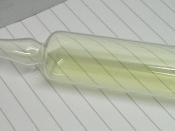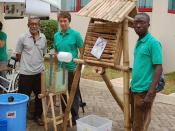The Element: Chlorine
General Information
We researched the chemical element known as chlorine. Chlorine has an atomic number of 17 and an atomic weight of 35.453. It has a valence number of 3. The element has 3 energy levels. Chlorine exists as a greenish-yellow gas at normal temperatures and pressures. Chlorine is second in reactivity only to fluorine among the halogen elements. Chlorine is a nonmetal. It is estimated that 0.045% of the earth's crust and 1.9% of sea water are chlorine. Chlorine combines with metals and nonmetals and organic materials to form hundreds of chlorine compounds. Chlorine is about 2.5 times as dense as air and moderately soluble in water, forming a pale yellowish green solution. Chlorine is so reactive that it never occurs free in nature.
Chemical Properties
Chlorine is in the halogen family, and like all the other halogen elements chlorine has a strong tendency to gain one electron and become a chloride ion.
Chlorine readily reacts with metals to form chlorides, most of which are soluble in water. Chlorine also reacts directly with many nonmetals such as sulfur, phosphorus, and other halogens. Chlorine can support combustion; if a candle were to be thrown into a vessel of chlorine, it would continue to burn, releasing dense, black clouds of smoke, The chlorine combines with hydrogen of the paraffin, forming hydrogen chloride, and uncombined carbon is left in the form of soot. Soot is black residue from fuel. Chlorine replaces iodine and bromine from their salts. Dry chlorine is somewhat inert or not able to move, but moist chlorine unites directly with most of the elements.
History
Chlorine was discovered in 1774 by Karl Scheele. Humphry Davy proved that chlorine was an element. Extensive production began 100 years later. During the 20th Century. The amount of Chlorine...


